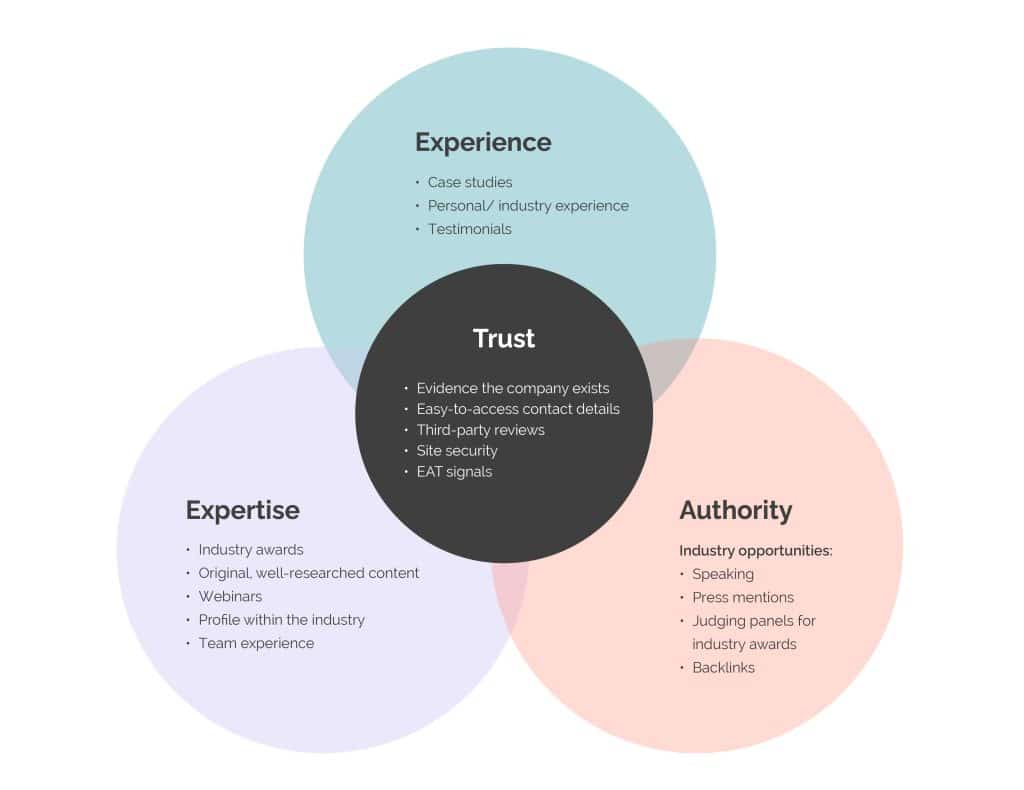What is E-E-A-T in SEO and why is it important?
The Basics
So just what exactly
is E-E-A-T?
Nothing edible, sadly. It stands for Experience, Expertise, Authority, and Trust.
In a nutshell, Google wants to see:
Click below to expand
You have the right experience to be talking about this topic. If it’s a product, has the person writing about it actually used it? If it’s a solution, has the author or company got the right knowledge of the problem they’re trying to solve? They want to know that you’ve been there, done that, and got the damn t-shirt, not just scooped up a load of information from elsewhere on the internet and regurgitated it in a slightly different format (naming no names, ChatGPT).
Your expertise in the area is obvious. Now, as a young website or a start-up, this might not be immediately possible. But if that’s the case it needs to be at the forefront of your strategy to find ways to showcase this as you gain traction.
You have the relevant authority in the industry. Would other websites in your area link to you comfortably? Have you won any awards?
You, and your site or product, can be trusted. All of the above feeds into this final concept. If Google is in any doubt that your site can’t be trusted, it’s going to score you poorly against the Search Quality Guidelines and this will impact your rankings (and, let’s face it, your conversions!). There are some topics where this will be more important than others. Google calls these YMYL sites – Your Money or Your Life. Dramatic? A little. But if you’re looking for medical advice, financial advice, or anything else that has big consequences (even if that just means that money is changing hands), E-E-A-T applies more than ever.
Google can’t tell all this, surely?
Yup. Or rather, a combination of their world-famous algorithms and their mysterious teams of Quality Raters can. The algorithm is trained to pick up on signals that feed into each of these areas, and scores your site accordingly. The E-E-A-T principle and Google’s “Helpful Content” update is aimed at ensuring that the sites ranking highest are going to answer the user’s question accurately.
How do you measure E-E-A-T?
“Very high quality main content should be highly satisfying for people visiting the page. Very high quality MC shows evidence of a high level of effort, originality, talent, or skill. For informational pages, very high quality MC must be accurate, clearly communicated, and consistent with well-established expert consensus when it exists. Very high quality MC represents some of the most outstanding content on a topic or type that's available online. The standards for Highest quality MC may be very different depending on the purpose, topic, and type of website.”
- Your authority score according to SEO tools. Each one will call it something different, but they will usually give your domain authority some sort of ranking. This uses factors like backlinks and mentions to decide, so it’s not as subjective as true E-E-A-T.
- If you have terms ranking on page one already, take a look to see if you’re getting any featured snippets or people also ask inclusions. These are a good sign that Google sees your site as authoritative.
- Analyse your organic traffic around known Google updates. If you see a decrease (which might be why you’re here!), there is likely an issue with your E-E-A-T.
If you’re after more clarity, the Search Quality Raters Guidelines are an in depth guide to what Google is looking for when they assess websites.
If it’s so subjective, how on earth do you implement E-E-A-T?

Not sure where to get started? We can send you some quick tips!
what's next?
Include ongoing E-E-A-T SEO activities into your strategy
- Actively collect reviews and manage them - and reply to the bad ones!
- Make sure they are displayed on the site and ideally through a third-party to reassure potential customers
- Keep on top of opportunities to enter relevant awards
- Keep to your content strategy to produce authoritative, shareable content that will hopefully bring you some good quality backlinks
- Regularly review your website to make sure it’s representative of who you are and what you’re doing
In essence, E-E-A-T is Google’s way for ensuring that the right content ranks for the right reasons. They want to minimise content and websites that are written with the search engine in mind and prioritise that which is written for the user.
However, we know that this can all seem pretty overwhelming so if you want some help assessing your site against the E-E-A-T principles, fill out an SEO Audit and we’ll give you a couple of pointers!





